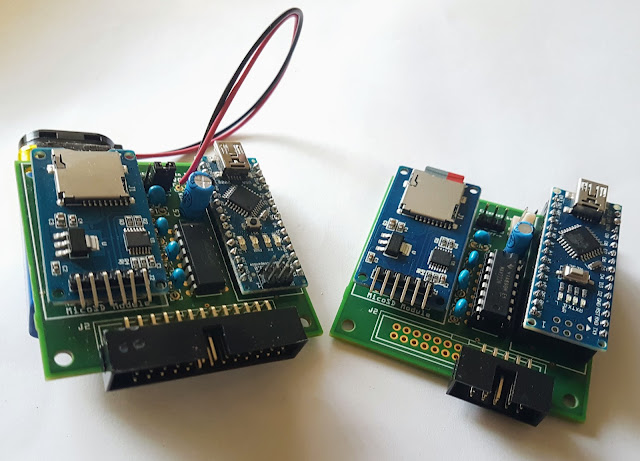After a bit of a wait the MyTeSed for the TSR-80 Model 100 enters the construction stage. A simple SD card reader is in sight, though not until a few challenges are met. Mostly the build went smoothly, mostly being down to one misguided assumption in turn inducing lot of time spent waiting.
 |
| Two MyTeSeds, one attached to a Model 102 and the other connected a Model 100 |
This is the first time I've had PCBs produced by a fabrication house, for every other project I've made them myself. The end result is a really impressed impressive sight, and the quality is quite amazing. The quality of the PCB lends a certain confidence to the endeavour of populating it.
I had assumed I'd be able to de-solder the right angled header pins from the micro SD module and then attach the module to the pins I'd soldered onto the main PCB. This of course turned out to be a very bad idea, leading ultimately to the complete destruction of a module. It seems the modules PCBs just aren't up to that kind of meddling. The lesson here I suppose is to never assume anything will work quite as planned.
 My misguided assumption cost me a couple of weeks, I only had the one SD module to break, I found myself needing toprocure some more modules from China, leaving me floundering before proceeding any further. Oh well, live and learn.
My misguided assumption cost me a couple of weeks, I only had the one SD module to break, I found myself needing toprocure some more modules from China, leaving me floundering before proceeding any further. Oh well, live and learn.A little wiser and with some new modules in hand, the easiest solution to my problem was to attach some cutoffs to the bottom of of an SD card module and then solder those into the PCB mounting holes as originally intended. I'd probably choose to mount the modules in the same way next time around as it worked near enough to originally planned.
 I'd sensibly procured a number of spare SD modules, so decided to build up a second MyTeSed, allowing me to make one very minor change. The first build used a full length 26 pin IDC socket, this really isn't needed as there are only 3 pins in use, from pin 1 to 3 (GND,TX and RX). I switched to a 10 pin IDC socket, this makes the IDC cable a lot easier to construct, a lot easier to connect, easier to move around and ever so slightly cheaper to build (if a few cents are of concern).
I'd sensibly procured a number of spare SD modules, so decided to build up a second MyTeSed, allowing me to make one very minor change. The first build used a full length 26 pin IDC socket, this really isn't needed as there are only 3 pins in use, from pin 1 to 3 (GND,TX and RX). I switched to a 10 pin IDC socket, this makes the IDC cable a lot easier to construct, a lot easier to connect, easier to move around and ever so slightly cheaper to build (if a few cents are of concern).Lastly I mounted the Arduino Nanos, I chose to solder the first Nano directly to the initial PCB build, on the second board I mounted on a couple of pin sockets first. This second option is the recommended choice if planning to re-use the Nanos' in other projects, though I figured I'll have at least one of these SD readers around for some time to come.
The good news is that after all the waiting for parts the end result worked as expected. The only really major component of the initial project left to sort out is software, again as I'd managed to kill the original SD module I had nothing to test with until I got to this point. I've subsequently had some time move forwardon that, which will form the basis of the next post.
 |
| The two versions of the MyTeSed, the first build with full 26 pin IDC cable (9v and battery attached) |













Hi looks good to me please keep us updated Thanks Darrell
ReplyDeleteI'd really like to build one of these for my model 100
ReplyDelete